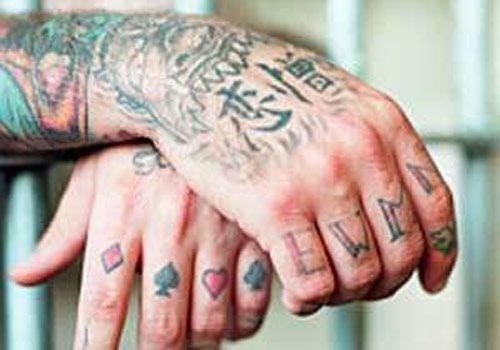Ink Behind Bars: The World of Prison Tattoos

In the clandestine world of incarceration, where freedom is but a memory, prison tattoos emerge as a unique form of expression and a silent language that speaks volumes within the confines of cellblocks and yards. These indelible ink marks etched beneath prison walls tell stories of identity, affiliation, and survival.
The Artistry Behind Bars
Within the stark, unforgiving walls of correctional facilities, the art of prison tattoos flourishes. Contrary to conventional tattoo studios, these makeshift parlors are far from sterile, often using improvised equipment, like sharpened paperclips or the motor of an old cassette player. The ink is derived from an assortment of sources, from pen ink to the soot of burnt rubber or plastic.
Ink as Identity
Prison tattoos play a pivotal role in establishing one’s identity and status behind bars. These marks signify not only one’s affiliation but also the length of their sentence, the crimes they’ve committed, and their role within the prison’s social hierarchy. A simple web of lines on the elbow might denote that an inmate is serving a life sentence, while a teardrop under the eye can be a symbol of having taken a life.
Gangs and Symbols
Gangs within the prison system often employ prison tattoos as a means of identifying their members and asserting dominance. For instance, a spider web tattoo on the elbow signifies entanglement with drugs, while a spider crawling on the neck indicates that an inmate is an enforcer for their gang.
The Dot Code
In the world of prison tattoos, dots take on unique significance. A single dot on the hand can indicate that an inmate is in search of illicit substances, while a series of dots might represent the number of times an individual has been incarcerated. These dot codes, concealed within seemingly simple designs, carry a complex narrative of an inmate’s history.
The Struggle for Normalcy
For many inmates, prison tattoos are an attempt to maintain a semblance of control and self-expression within the rigid confines of incarceration. This struggle to retain a sense of self often leads to tattoos that celebrate their pre-incarceration lives, whether through names, symbols, or images.
The Price of Visibility
While prison tattoos are a means of expressing oneself and navigating the social structure within prison, they come with significant risks and consequences. Tattooing within the confines of the prison can be a dangerous practice due to the lack of hygiene, making inmates susceptible to infections and diseases.
The Regret and the Removal
After release, many former inmates regret their decision to get prison tattoos, as they can serve as permanent reminders of a past they wish to leave behind. In the outside world, these tattoos can carry negative connotations, affecting employment prospects and relationships.
The Evolution of Prison Tattoos
In recent years, the art of prison tattoos has evolved. Some former inmates, now professional tattoo artists, have used their experiences to create meaningful and rehabilitative opportunities. By offering cover-up and removal services, they aim to help others shed the visible reminders of their time behind bars.
Unspoken Narratives
Each line, dot, and symbol tells a unique story within the realm of prison tattoos. From the stark simplicity of teardrops to the intricate codes hidden within the ink, these marks serve as more than just adornments. They are, in many ways, silent memoirs that encapsulate the tumultuous lives and experiences of those confined to the unforgiving world of incarceration.
In this realm of limited choices and restricted freedoms, the world of prison tattoos stands as a testament to the human drive for identity and expression. These inky narratives, though forged in adversity, are windows into the intricate lives and experiences of those who carry them—those who have known the world behind bars.




